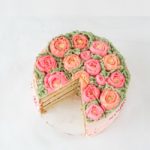
Almond Cake with Chocolate, and Amaretto Buttercream
This almond layer cake is rich and full of almond flavor, without the need for extra almond extract. Amaretto is an under-used liqueur in my cabinet, and it pairs nicely with the almond cake and thin layer of chocolate.
Servings 10 servings
Ingredients
Cake
- 7 ounces Odense almond paste thinly sliced
- 1 1/2 cups granulated sugar (297g)
- 3 large eggs
- 2 egg yolks
- 1 tablespoon pure vanilla extract
- 3/4 cup sour cream
- 1/4 cup buttermilk
- 2 cups all-purpose flour (284g)
- 3/4 teaspoon baking powder
- 3/4 teaspoon baking soda
- 3/4 teaspoon salt
- 1/2 pound 2 sticks; unsalted butter, room temperature, cut into 1-inch pieces (227g)
Amaretto Buttercream
- 8 large egg whites
- 2 ¼ cups granulated sugar (446g)
- ¼ teaspoon salt
- 1 ½ pounds 6 sticks; unsalted butter, room temperature (678g)
- 2 teaspoons pure vanilla extract
- 2 tablespoons Amaretto liqueur
- 3 ounces bittersweet chocolate, melted (to use after the cake is cooled) (85g)
Instructions
For the cake
- Adjust an oven rack to the middle position. Preheat the oven to 350F. Butter and flour two 8 by 2-inch round cake pans and line the bottoms with parchment paper.
- Place the almond paste and sugar in a food processor. Pulse until the almond paste is finely ground and the mixture resembles sand.
- In a medium bowl or liquid measuring cup, whisk the eggs, egg yolks, vanilla, sour cream, and buttermilk.
- In a bowl of a stand mixer fitted with a paddle, mix the sugar and almond paste mixture, flour, baking powder, baking soda, and salt on low until combined. With the mixer running on low, add the butter one piece at a time, beating until the mixture resembles coarse sand. With the mixer still running on low, slowly add half the wet ingredients. Increase the speed to medium and beat until incorporated, about 30 seconds. with the mixer running on low, add the rest of the wet ingredients, mixing until just combined. Increase the speed to medium and beat for 20 seconds (the batter may still look a little bumpy). Scrape down the sides and bottom of the bowl, and use a spatula to mix the batter a few more times.
- Divide the batter into the prepared pans and smooth the tops. Tap the pans gently on the counter 2 times to help get rid of any bubbles. Bake 35 to 50 minutes (see note above), rotating the pans halfway through, until the cake are golden brown and a wooden skewer or toothpick inserted in the center comes out clean.
- Transfer the pans to a wire rack and let cool for 30 minutes. Turn the cakes out onto the rack, remove the parchment paper, and let cool completely before frosting.
For the buttercream
- Put about an inch of water in a medium saucepan and bring it to a gentle boil.
- In the bowl of a stand mixer, stir the egg whites, sugar, and salt until combined. Put the bowl over the saucepan, being careful not to let the water touch the bottom of the bowl. Stir with a rubber spatula until the sugar is completely melted, and the mixture reaches a temperature of 160F, about 4 to 5 minutes. While you are stirring, be sure to scrape down the sides of the bowl with the spatula—this will ensure no sugar grains are lurking on the sides and will help prevent the egg whites from cooking.
- Remove the bowl from the heat and place it in the stand mixer fitted with a whisk. Whisk the mixture on medium-high until stiff, glossy peaks form, 8 to 10 minutes.
- With the mixer running on low, add the butter, 1 to 2 tablespoons at a time, beating well after each addition until incorporated and the buttercream is smooth. Add the amaretto and vanilla. Beat on low until combined.
To assemble the almond cake
- Line two baking sheets with parchment paper. Cut each layer of the cake in half horizontally, to make a total of four layers, and place the layers on the prepared baking sheets, cut sides down. Top three of the layers with a thin coating of chocolate (1 ounce on each piece), spreading it thin and evenly along the whole surface of each layer. Let the chocolate set before frosting the cake (you can put the layers in the freezer for 2 or 3 minutes to speed this up).
- Put one cake layer, chocolate side up, on a turntable or serving plate and top with ¾ cup of buttercream. Repeat with two more chocolate-covered layers and then top with the remaining, chocolate-free layer. Frost the cake as desired.